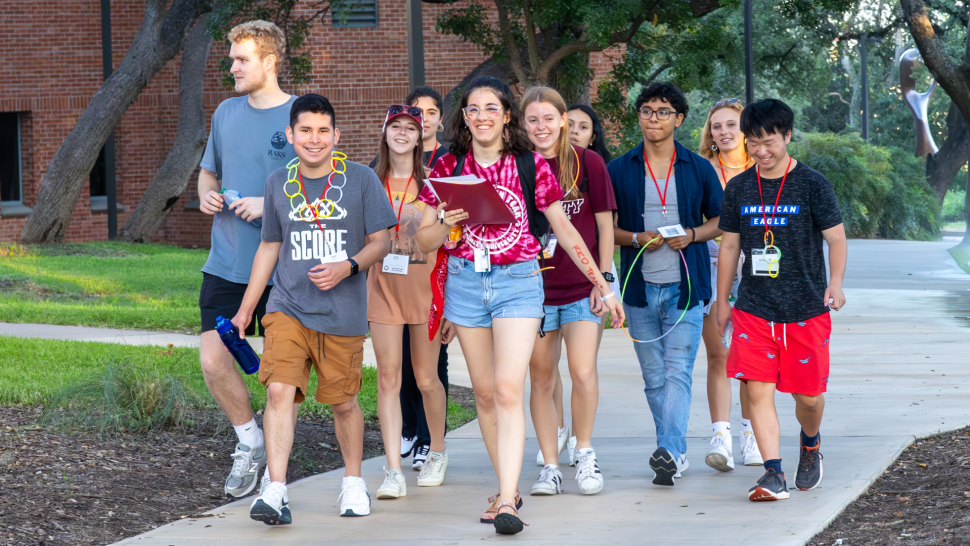
A diverse and academically competitive cohort, Trinity University’s newest class of 664 students brought the University’s acceptance rate to an all-time low in admissions history. With 11,425 applications received, only 3,217 applications were accepted, lowering the acceptance rate from 31% in 2022 to a record-breaking 28% in 2023.
“The acceptance rate this year signals a visible indicator of increased selectivity among this entering first-year class,” says Justin Doty, dean of Admissions. “While this new percentage is making Trinity history, it is just one of many metrics used to assess competitiveness among this entering class. Ultimately, our end goal is to attract and enroll students who are a good fit for our institution and who will thrive both academically and socially in the Trinity community.”
Each year, the admissions team continues to see both an increased volume of applications and a higher academic profile among applicants. “To enroll the desired first-year class number and the right types of students requires part art and part science,” Doty says. “It also requires total support from our faculty, coaches, staff, and current students to recruit these talented classes. We are beyond grateful to have a campus community that is extremely committed to our recruitment efforts,” Doty says.
The Class of 2027 boasts an average GPA of 3.75 out of an unweighted 4.0 scale, which mirrors the average GPA of 3.75 from the prior year. Forty-three percent of the entering class submitted official SAT or ACT test scores, with the remainder opting to be evaluated under Trinity’s test-optional admission policy. For those who submitted official test scores, the average ACT is 31, and the average SAT is 1398, both of which are comparable to the Class of 2026.
Nearly a quarter of the class, 22% of students, have been recruited as Tiger student-athletes to participate across Trinity’s 18 varsity sports teams. Approximately a quarter of the new students will ultimately participate in Trinity fine arts.
Many of the new students identified Trinity as their top choice school during their college search process, breaking another school admissions record. The incoming first-year class marks the highest number of students who committed through Trinity’s binding Early Decision (ED) program. A total of 150 students enrolled through ED, representing almost a quarter of the entering class, which is a 36% increase compared to the previous enrollment cycle. Additionally, Trinity’s ED cohort this year is bringing both a higher academic profile (average GPA, testing, class rank) and a higher percentage of students of color (53%) compared to previous ED populations.
“We are absolutely thrilled by the increased volume, academic caliber, and composition of our ED population this year,” Doty says. “These are students who are ‘all in’ and committing themselves to Trinity early in the process. In turn, we are offering our full support to them.”
The Class of 2027 continues to show its diversity in multiple ways. As an overall class, 49.9% are students of color. With the rise in racial and ethnic diversity, Doty and the admissions team are picking up on a new trend of a high number of students who identify as multi-ethnic.
“What was uniquely interesting within our students of color population was the fact that we witnessed a much higher percentage of students identifying themselves as multi-ethnic by selecting multiple races and/or ethnicities on their application. Last year this represented 3.4% compared to 7.5% this year—a very significant increase,” Doty mentions.
Geographically diverse, students in the incoming class represent 32 states and 27 countries. Trinity’s top-producing states within the first-year class come from California, Colorado, Washington, Louisiana, and Oklahoma. The 32 first-year international students represent a variety of countries, with the majority coming from Vietnam, Ecuador, Mexico, the United Kingdom, and India.
Trinity’s incoming students are not only ethnically and geographically diverse but also represent a mix of educational and economic backgrounds, with 13% of the incoming first-year students considered to be first-generation students. The incoming class also has 21% of its students receiving Pell Grants, which are provided to families demonstrating the greatest financial need.
The Class of 2027 has already exhibited perseverance, strength, and determination before even stepping onto Trinity’s campus. Welcome to campus, Tigers!
The data in this article is accurate as of August 4, 2023.